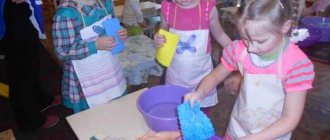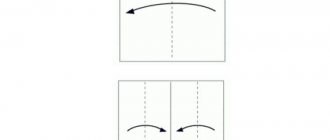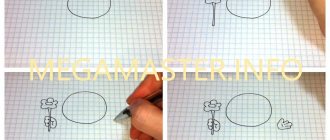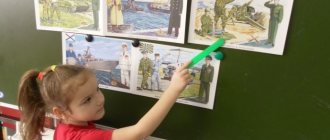Artistic work in preschool educational institutions
Artistic work in preschool educational institutions
(based on personal work experience)
The Concept for the Modernization of Preschool Education emphasizes the priority of solving problems aimed at creating a creative atmosphere and conditions for innovative activity. The authors of the Concept point out that the child, first of all, is introduced to eternal universal values (beauty, goodness, truth). As a result of this, he is born and develops such core personality qualities as independence, initiative, arbitrariness in the form of a desire to overcome difficulties, as well as the need for active development and creative transformation of the surrounding reality
In the target guidelines of the Federal State Educational Standard for Preschool Education, a child at the stage of completing preschool education must have a developed imagination, which is realized in various types of activities; the child must have a positive attitude towards the world, towards different types of work at the stage of completing preschool education
The creative principle in a person is always a striving forward, for the better, for progress, for perfection and, of course, for beauty in the highest and broadest sense of this concept. It is this kind of creativity that manual labor in preschool age fosters in a person, and in this function it cannot be replaced by anything.
Artistic manual labor is the work of a child with various materials in order to create useful and artistically - aesthetically significant objects and products to decorate his life, games, work and leisure. This child labor is a decorative, artistic and applied activity, since the child, when creating beautiful objects, takes into account the aesthetic qualities of materials based on his ideas, knowledge and practical experience acquired in the process of work.
The purpose of artistic work is the directed and consistent education of aesthetic and everyday culture in children, promotion of personal growth and the formation of an emotional and value-based attitude towards the world around them.
Preschool age provides excellent opportunities for developing creativity. And the creative potential of an adult will largely depend on the extent to which these opportunities were used.
The main directions in the development of creative abilities of children of senior preschool age through manual labor are: the development of imagination and the development of thinking qualities that form creativity. When organizing manual labor, I take into account the main stages of children’s creative activity:
Stage 1 - the emergence of a plan;
Stage 2 - the process of creating a product of creative activity;
Stage 3 - analysis of the results.
When working with preschoolers, I always comply with the following conditions:
– I organize classes in such a way as to bring a positive emotional attitude to children and to educate children in moral concepts;
– I take into account the interests of boys and girls;
– To give the classes a teaching and developmental character, I complicate technical and visual means;
– I take into account the age and individual characteristics of children;
– each craft always finds a specific practical application;
The results of productive activities always receive approval, praise and are advertised to parents and other groups.
Working in this direction, I use effective methods and techniques: musical accompaniment, compliance with safety rules when working with scissors, demonstration and explanation, use of artistic expression, consideration of work sequence diagrams, activation of children’s speech, finger gymnastics, practical activities of children, clarifying questions about the sequence of tasks, assistance to children from an adult and a child, analysis, self-esteem of children.
Children actively work with various materials: fabric, foam rubber, polystyrene foam, various types of paper (plain, corrugated, newspaper, napkins, cardboard), natural materials (cones, conifer needles, bark, fruit and berry seeds, etc.), Waste material (reels, boxes, etc.)
To maintain interest in manual labor and the desire for independence, we make crafts that do not require complex processing and require minimal time, since preschoolers cannot wait long for the result of their labor.
When analyzing the work, I draw the children’s attention to the neatness of the craft and its individuality. Before starting to make crafts, I conduct conversations with children to familiarize themselves with the properties of materials, and talk about the use of these materials in everyday life. Children began to bring various textures of fabrics, papers, etc. to kindergarten. As a result, we have collected entire collections that children love to look at and tell where these wonderful materials came from. We photograph all the crafts and collect them in an album.
All the crafts made by the children’s hands “live” in the group’s theater, are collected for playing out games with construction sets, a reception area is decorated, and donated to other groups, i.e. all the crafts are appreciated and treasured with gratitude to the children. Children see this and strive for other successes, they have new fantastic ideas, a desire to do something nice for others. As a result, children develop a system of certain skills, knowledge and abilities for making crafts.
My children love working with paper. They have mastered the following kaka actions: bending, cutting, tearing and tearing, and gluing. Through experimenting with paper, children learned that paper can be soft, hard, of varying thickness and strength, shiny and matte, and of all kinds of colors. The children themselves came to the conclusion that they could act with her in different ways. Each time, using paper of different quality, the children experienced more or less stress, which had a positive effect on the development of fine motor skills. Didactic games “What’s rustling?”, Guess by touch, etc. helped develop auditory attention in children.
I have always paid great attention to assessing children's activities, teaching children to see what worked well and what did not. And most importantly - why, what else needs to be learned. I drew the children's attention to the originality of the idea and the unusual method. In our group, a tradition was born - decorating the hall for the holidays. And this is very responsible and my students always coped with this task well, received the approval of adults and words of gratitude. I think that this side of education will help children in school to be careful with their possessions at school and at home.
All materials are concentrated in the labor corner. They are always available and safe for children. Together with children and parents, we replenished our magical corner.
Of course, such success cannot be achieved without parents. The parents of my students have always been active participants in the holidays, jointly making decorations, details for costumes, and joint creative exhibitions. I believe that the main thing is that children have acquired interest, desire, an emotional mood has been created, children began to understand that in any activity you need to put in effort and patience, and then you will receive satisfaction and high appreciation from friends and adults. Parents' help helped children not to leave work unfinished when difficulties encountered.
As a result, children became liberated, active, kind and responsive, and more sociable. Children acquired a strong interest in various types of construction and manual labor. When making crafts, they use knowledge about materials, which helps them create durable and beautiful crafts for use in play and long-term preservation. My graduates are ready for school. I am sure that they will be active participants in creative exhibitions.
Summary of work activities for children of the senior group Type of labor: Manual labor
Summary of work activities for children of the senior group
Type of labor: Manual labor
Form of organization: Collective
Target:
create conditions for children's creative activity
Tasks:
Educational: To consolidate knowledge and skills when working with paper and scissors. Strengthen the ability to trace according to a template.
Educational: develop imagination and creativity.
Educational: cultivate sympathy for game characters, patience, perseverance, accuracy.
Methods and techniques:
surprise moment, fairy tale, demonstration of a method of action, question and answer, encouragement.
Equipment:
scissors, rectangular paper pieces, templates with figures of men, colored pencils or felt-tip pens.
Progress:
Motivation:
The teacher shows the children a paper man with a sad face (on the other side with a cheerful face).
Educator:
Look who came to us. Some little man. Look - is he happy or sad?
Children:
Sad.
Educator:
Sad little man, where are you from?
— I live in a fabulous paper country. This is a country of very kind people. We lived together, helped each other, had fun together. But then one day trouble happened. An evil wizard has appeared in our fairy-tale land. He saw beautiful paper houses, paper gardens, paper flowers. Do you think he liked it? No, because he is evil. He crushed and tore all the flowers and trees, and turned the funny little people into empty pieces of paper. I was the only one who survived because I managed to hide. When the evil wizard left, I collected all the pieces of paper, that's all that was left of my cheerful friends. I went to look for the good wizard. I was told that there are many good wizards in your garden. And I came to ask you for help. Oh, good wizards, please turn my enchanted friends back into cheerful, kind people.
Activity planning:
Educator:
Guys, what do you think - can we help the sad little man? We have everything you need for this. To do the magic right, let's consider our guest. That he has?
Children:
head, torso, arms, legs
Educator
: How can you make a man out of paper?
Children:
Draw and cut.
Educator:
That's right, but we won't just draw a little man, we'll trace it according to a template, cut it out, color it and make a garland of friendly and cheerful little people.
Implementation of the plan:
Children receive blanks of paper folded in three layers like an accordion and templates of people (girls and boys) and get to work. The teacher quietly turns the little man over to the other side with a cheerful face. Draws children's attention to the fact that the little man is cheerful because you children, good wizards, have turned pieces of paper into his friends. With the help of a little man, the teacher tells the children how to draw clothes and jewelry.
Crafts from semolina
Crafts in the senior group of kindergarten should not only entertain, but also develop the child. Semolina paintings are great for showing physical processes.
- Draw or print a template on paper, it can be any character;
- Invite your child to coat the design with PVA glue inside the outline;
- Sprinkle semolina over the glue with your child, shake off the excess;
- When the semolina dries a little, decorate the cereal with watercolors.
The paint will spread smoothly and the semolina will swell. This technique allows you to beautifully mix colors.




